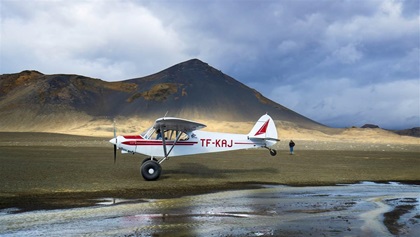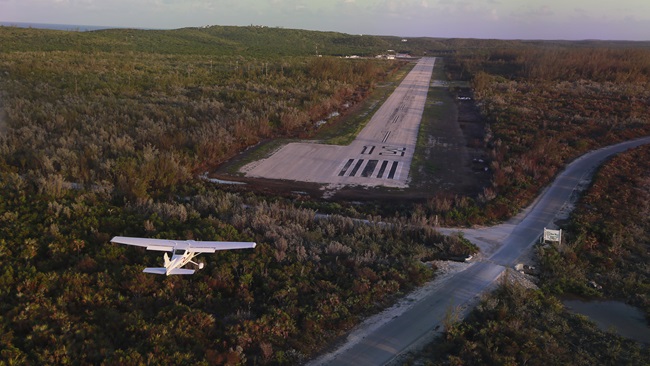Touchy subject
The right place and the right time for wheel landings

There’s a sometimes comically strident divide between the “they ground loop as soon as they’re untied” school of thought and the “you’re not a pilot if you don’t fly a tailwheel” group. But one controversy is even more hotly discussed inside the tailwheel community: To wheel land or not to wheel land? That is the question.
A three-point landing is when the airplane touches down on all three wheels just as the airplane stalls. It is a tail-down, minimum-speed touchdown. A wheel landing is done on just the main gear in a nearly level attitude, the tail off the ground, at a higher speed. Essentially, the airplane is flown onto the ground. A wide variety of conditions determine whether a pilot should be doing wheel landings. Also, when it comes to being able to handle adverse conditions, not all tailwheel airplanes are created equal: The effect of a given type of wind, for instance, varies greatly depending on the type of airplane being flown.
So why is a wheel landing needed in the first place? This is probably where the controversy begins and where opinions initially diverge.
At the root of the need for wheel landings is the need to have total control of the airplane at the moment of touchdown. So, what is it that challenges our ability to control the touchdown? Ignoring irregular runway surfaces (uphill, downhill, rough), wind presents the biggest challenge. However, it’s not so much the strength of the wind (velocity) as it is the character of the wind. Specifically, the gusts.
A steady headwind, regardless of its strength, is a pilot’s friend. It slows everything down. A part of a steady crosswind is on the airplane’s nose, so it also slows us down. As long as the wind is steady and the crosswind component is within the capabilities of the airplane, we can then establish the just-right wing-down angle to keep the airplane moving parallel to the centerline. At the same time, the fuselage is aligned with the centerline using the rudder. Contrary to what some nay-sayers say, this classic wing-down, opposite-rudder technique allows us to three-point almost any tailwheel airplane with no problem in a steady wind. It just takes an understanding of the dynamics that are in play as well as determination on the controls.
There is no hard and fast rule as to when a pilot should use a wheel landing, but most pilots do it when the gust factor is a certain percentage of the touchdown speed.
Enter the gust factor. When a gust—which is a quick, momentary increase in wind speed—hits an airplane, for a moment the airplane’s inertia resists the wind trying to slow it down. The wings see an instantaneous, but short-lived, increase in airspeed and the extra lift it generates. As the gust dies or changes direction, the extra lift disappears. Sometimes these changes can be abrupt, or even violent.
The lift being generated by the wings is a function of the square of the speed of the wind over the wings, so an increase in airspeed causes an increase in lift. During gusts, the airplane first wants to climb (balloons), and then, the gust gone, the airplane comes down. This all happens when the airplane is most vulnerable: just before touchdown, when it’s slow and has the highest angle of attack. So, when three-pointing in a gusty wind, there is the risk that a gust will pick the airplane up, then quickly abandon it. At that point, the airplane assumes the gliding characteristics of a clod of dirt and makes a dramatic arrival.
Now take the wind off the nose and make the enemy a gusty crosswind. In a steady wind, the crosswind correction control is also steady and fairly easy to apply and monitor. If the wind has sufficient gusts, however, the crosswind correction is constantly changing. Plus, the airplane is slowing down for landing, so the effects of the gusts increase just as the airplane’s aerodynamic control is disappearing. Whether a nose-on wind or a crosswind, these gusty conditions are what the wheel landing is designed for.
When wheeling the airplane on, the approach speed is increased (half the gust factor is a common increase) and the airplane lands at a higher speed than normal. This is accomplished by flying it onto the ground in a more or less level attitude. The airplane isn’t slowed to stall speed. This gives the pilot more positive aerodynamic control by lessening the effect of the gust-induced changes in lift. The excess speed is burned off on the runway while the airplane maintains a slightly negative angle of attack using forward stick. The resulting down force keeps it glued to the runway, resisting the gusts that would like to pick it up.
There is no hard and fast rule as to when a pilot should use a wheel landing, but most pilots do it when the gust factor is a certain percentage of the touchdown speed. On a Cub or a Champ that lands at 35 mph, that might be only 5 to 7 mph. A Pitts Special that touches down at more than 70 mph can tolerate much higher gusts. The heavier and faster the airplane, the higher the gusts can be. When in doubt, wheel it on in gusty winds.
That’s the theory behind the appropriate application of the wheel landing in general aviation airplanes (as opposed to transports and heavier aircraft): Its primary purpose is to give an increased margin of control over gusts.
The pros and cons of wheel landings
Wheel landings have positives and negatives. The positives include the ability to maintain control of the airplane over forces that would like to spoil your day. Hidden within the positives is at least one major drawback.
The heavier and faster the airplane, the higher the gusts can be. When in doubt, wheel it on in gusty winds.When a tailwheel airplane is sitting on the runway with the little wheel on the ground, its tendency to weathervane into the wind is easily felt. However, as long as the wind isn’t ridiculous, it is easily controlled. The tailwheel carries enough weight that using the rudder pedals and an occasional brake allows the pilot to overcome most winds.
So, the tailwheel is the airplane’s ultimate control when it’s on the ground because, among other things, it needs no airspeed to function properly. I repeat: It works well when it’s on the ground. In the initial phases of a wheel landing, the main gear is on the ground but the tail is held up with forward stick. Eventually, however, the tail will run out of lift and, whether we want it to or not, it’s going to come down. Proper technique is to not wait until it falls, but to gently lower it just before it falls on its own.
 While the tail is coming down to the ground, there is a brief period when the usual steering mechanisms, the rudder and the tailwheel, are either ineffective or not part of the equation. If the crosswind is strong or gusty, the airplane is at the mercy of the wind while the tail comes down. You may find yourself using both rudder and brake for a few seconds to maintain heading until the tailwheel makes contact. There is no way to avoid this, so it is important to recognize the possibility of directional control surprises during that very brief period. If the wind is on the nose this isn’t a big deal, gusts or not.
While the tail is coming down to the ground, there is a brief period when the usual steering mechanisms, the rudder and the tailwheel, are either ineffective or not part of the equation. If the crosswind is strong or gusty, the airplane is at the mercy of the wind while the tail comes down. You may find yourself using both rudder and brake for a few seconds to maintain heading until the tailwheel makes contact. There is no way to avoid this, so it is important to recognize the possibility of directional control surprises during that very brief period. If the wind is on the nose this isn’t a big deal, gusts or not.
Another drawback to wheel landings is that they put you on the ground at a higher-than-normal speed. Sometimes that’s necessary, sometimes it isn’t. The faster we’re going on the ground, the more runway it will take to stop. And, if we let a taildragger start wandering around, the more exciting the rollout will be because the location of the center of gravity in a tailwheel airplane amplifies any drift or yaw. On landing, slow is good.
The myths, explanations, and excuses
Pilots sometimes make wheel landings when they don’t need to. So, if the conditions don’t demand it, why do some pilots do it?
“Visibility is better.” Landing in a nearly level attitude does make it easier to see over the nose. However, most of these airplanes are easy to three-point, so why put them on the ground with excess speed if it’s not needed?
“It’s easier.” This is debatable. Yes, being able to see the entire runway makes it easier to land straight. This is one reason why wheel landings work so well in hard, gusty crosswinds. The excess speed does, however, complicate the ground handling. Even worse, in some cases the wheel landing is used as a crutch to keep from having to develop the finesse needed in making a three-point. That’s a lazy way of thinking.
“It’s needed in a crosswind.” If there is no gust factor, a wheel landing isn’t needed. Even a lightweight like a Piper Cub can handle more crosswind in a three-point than most pilots can imagine.
“It’s needed in a high wind.” Another myth. Landing some tailwheel airplanes in a high wind that’s on the nose feels like landing a helicopter because your forward speed is slowed down so much. Landing in a high, steady on-the-nose wind can be a heck of a lot of no-sweat fun.
Do what is appropriate for the conditions and the airplane. It’s important tailwheel pilots be familiar and comfortable with making wheel landings. However, it’s just as important they know when to use them. Nothing is prettier than a well-done three-point. Nothing is uglier than an airplane being dropped hard by a gust. So, know when wheelies are and are not needed.


